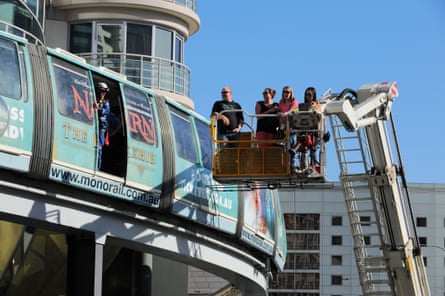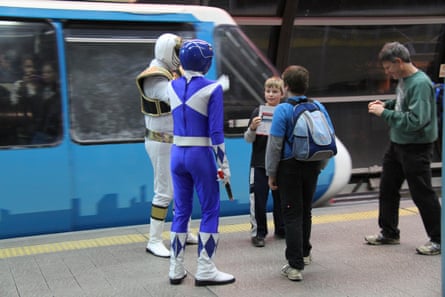Ever since a 1993 episode of The Simpsons about a travelling salesman selling a dodgy monorail system to Springfield, the word has been satiric shorthand for a flashy but faulty project governments jump to waste money on.
In Sydney, mention of “the monorail” carries a similar, slightly more embarrassing weight in the city’s collective memory.
Friday marked 10 years since Sydney’s monorail ran its final loop, after 25 years of loyal, if sometimes unreliable, service.
Opening in 1988, when a city of roughly three and a half million people were crying out for mass transport alternatives to unclog the city, the Sydney monorail had the potential to service remarkably few people.
With eight stops along a 3.6km, single-direction track, the monorail won out over a rival push for a light-rail line as the transport option to link Sydney’s central business district with the newly repurposed Darling Harbour precinct.
Despite the controversial concept of erecting a rail line mere metres above the heads of city streets that hundreds of thousands of pedestrians walked each day, the offer by operator TNT to build the line for free was one sweetener that ultimately led the then New South Wales government, with Neville Wran as premier, to pick the monorail.
While it opened to some fanfare, the years leading up to its launch were marred by protests.
Clover Moore, the current lord mayor of Sydney who was an independent MP and vocal opponent of the monorail, at the time, said it was “the most offensive structure to assault our city since the Cahill expressway” – a contentious motorway built adjacent to the picturesque Circular Quay and wedged between the Harbour Bridge and Opera House.

The prominent Sydney architect Harry Seidler called the monorail “the most tragic thing that happened to the urban fabric of Sydney”. The union leader and environmental activist Jack Mundy went further, saying the elevated rail line “represented the rape of the city”.
Each train could seat 48 passengers and, while services were frequent, the cost of a ticket and travel time failed to stack up in the eyes of Sydneysiders, especially because it was often faster to walk between stops.
Commuters made up just 9% of passengers and, with relatively expensive tickets from the private operator – a single trip cost $5 in the system’s final years – the monorail was mostly popular with tourists.
Patronage levels in the first few years were half what was expected. Repeated breakdowns, which required cherrypickers to rescue passengers, did little to entice new riders.
Louis Nowra, playwright and author of a biography of Sydney, recalls the momentum that gained pace behind the idea in the face of obvious issues.

“One of the things about Sydney is it’s kind of messy. Its streets are narrow and undulating, the bicycle paths go for a few hundred metres then stop, then start. It’s a very hard place for getting around generally, so everyone’s needing a transport solution,” Nowra tells Guardian Australia.
“The monorail just seemed to be one of those ideas that gathered steam and got completely out of control and nobody could stop it. They never thought ‘how is this actually going to work in a city like Sydney?’.”
Nowra says Sydneysiders took some time to become acquainted with the monorail’s strong presence in the city centre.
“When it went up it looked absolutely terrible. Watching it come up from Darling Harbour you thought it was going to sideswipe a building,” he says.
Nowra adds: “It wasn’t just visually horrific, it was very noisy. There was a hideous screech when you were under it, and people sort of bent down because they thought there was something coming overhead.”

While it was “much more of a toy in the vanguard of pushing Sydney as a flashy modern city than a serious transport solution”, Nowra recalls the bizarre experience of riding the monorail.
“It was a voyeur’s delight because you’d be coming in close to the first and second floor offices and you’d be looking in and seeing people working, despondent at their desk.
after newsletter promotion
“It was like watching a series of Edward Hopper paintings, to be able to see up-close the sad lives that office workers led. That was really a thrilling feeling,” he says.
In this way, the monorail was cemented as peculiar cultural icon of Sydney. Heath Ledger and Rose Byrne’s characters shared their first kiss in a monorail carriage in the Australian cult action classic Two Hands. A Power Rangers film, a Muppets video and a Bollywood blockbuster also featured the monorail.


Despite its product placement, patronage never reached potential.
“The monorail is not integrated with Sydney’s wider public transport network and has never been truly embraced by the community,” the then NSW premier, Barry O’Farrell, said when in 2012 he announced the monorail would be shut down.
News reports from 30 June 2013, its final day in operation, summed up its life. Many of those who turned out for a farewell ride admitted to also being first-time passengers.

In its 25 years, about 70m passenger trips were made – figures some Sydney train lines were approaching in a single year before the pandemic.
While its life was relatively short for a transport system, its legacy was lasting. The elevated train track and stations took years to dismantle and take down.
Proposals to convert remnant stations into bars failed to materialise. One station still remains hovering adjacent to the World Square shopping centre.
It was only in recent weeks that the final remaining track and stations at Darling Harbour were removed.
“Today we farewell one of the last remaining monorail stations,” the current NSW premier, Chris Minns, tweeted. “You were here for a good time, not a long one. Gone but not forgotten,” Minns said.
With deconstruction almost complete, today we farewell one of the last remaining monorail stations.
You were here for a good time, not a long one.
Gone but not forgotten. pic.twitter.com/cCJKpAsOyk
— Chris Minns (@ChrisMinnsMP) June 9, 2023
Nowra remains far less romantic about Sydney’s collective memory of its monorail.
He likens the decision to build the monorail to the plan to tear up the city’s extensive tram network in the 1950s and 1960s, and sees the monorail as a key roadblock in Sydney’s transport evolution that has seen it ultimately re-embrace light rail in recent years.

“The reason it’s taken 10 years to come down is because people were so embarrassed, it’s still such an embarrassment,” he said.
“As it completely disappears from the city, I think we’ll begin to forget it, but in Sydney it will only be another 10 years before somebody will come up with another idea just like it.”

